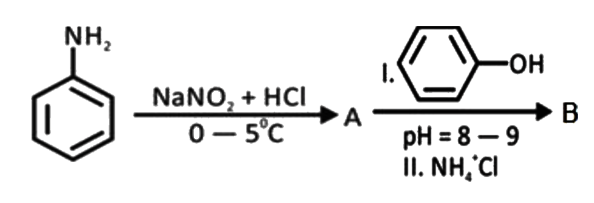In electrolytic reduction of a nitroarene with current efficiency, g of the electric charge. The molar mass of the compound is reduced by of electric charge. The molar mass of the compound is:
The correct Answer is:C
To find the molar mass of the nitroarene compound reduced in the electrolytic process, we can follow these steps:
1. Identify the Given Data:
- Weight of the compound reduced (m) = 20.50 g
- Current efficiency = 50%
- Total electric charge (Q) = 2×96500C
2. Calculate the Effective Charge:
Since the current efficiency is 50%, the effective charge used in the reaction is:
Qeffective=Current Efficiency×Q=0.5×(2×96500)=96500C
3. Determine the Number of Electrons Involved:
In the reduction of nitroarene, it is stated that 6 electrons are involved in the process. This can be derived from the change in oxidation state of nitrogen from +3 to -3.
4. Calculate the Moles of Electrons:
Using Faraday's law, the number of moles of electrons (n) can be calculated as:
n=QeffectiveF=9650096500=1mole of electrons
5. Relate Moles of Compound to Moles of Electrons:
Since 6 moles of electrons are required to reduce 1 mole of the compound, we can set up the relationship:
Moles of compound=n6=16moles
6. Use the Moles of Compound to Find Molar Mass:
The molar mass (M) can be calculated using the formula:
M=massmoles=20.50g16=20.50×6=123g/mol
Final Answer:
The molar mass of the compound is 123 g/mol.
---
- Weight of the compound reduced (m) = 20.50 g
- Current efficiency = 50%
- Total electric charge (Q) = 2×96500C
Since the current efficiency is 50%, the effective charge used in the reaction is:
Qeffective=Current Efficiency×Q=0.5×(2×96500)=96500C
In the reduction of nitroarene, it is stated that 6 electrons are involved in the process. This can be derived from the change in oxidation state of nitrogen from +3 to -3.
Using Faraday's law, the number of moles of electrons (n) can be calculated as:
n=QeffectiveF=9650096500=1mole of electrons
Since 6 moles of electrons are required to reduce 1 mole of the compound, we can set up the relationship:
Moles of compound=n6=16moles
The molar mass (M) can be calculated using the formula:
M=massmoles=20.50g16=20.50×6=123g/mol
The molar mass of the compound is 123 g/mol.
Topper's Solved these Questions
- BOOK - NARAYNACHAPTER - ELECTRO CHEMISTRYEXERCISE - AIEEE & JEE MAIN PREVIOUS38videos
ELECTRO CHEMISTRY
- BOOK - NARAYNACHAPTER - ELECTRO CHEMISTRYEXERCISE - NCERT BASED QUESTIONS8videos
ELECTRO CHEMISTRY
- BOOK - NARAYNACHAPTER - ELECTRO CHEMISTRYEXERCISE - LEVEL-II(C.W)61videos
ELECTRO CHEMISTRY
- BOOK - NARAYNACHAPTER - 15TH GROUP ELEMENTSEXERCISE - EXERCISE - 4 (NCERT EXEMPLERS/HOTs)27videos
15TH GROUP ELEMENTS
Similar Questions
Knowledge Check
- Question 1 - Select One
If the empirical formula of a compound is P2O3, what could be a possible molar mass of the compound .
A55 gB165 gC275gDnone - Question 2 - Select One
Electrolytic reduction of 6.15 g of nitrobenzene using a current efficiency of 40% will require which of the following quantity of electricity? [C =12, H=1, N=14,O=16]
A0.75 FB0.15 FC0.75 CD0.125C - Question 3 - Select One
Active mass of a 6% solution of a compound is 2 then calculate molar mass of compound.
A(A) 15B(B) 30C(C) 60D(D) 120
The mass of 525 ml of a gaseous compound at 28∘C and 0.970 bar pressure was found to be 0.900 g. Calculate the molar mass of the compound.
View SolutionA quantity of electrcity required to reduce 12.3 g of nitrobenzene to aniline arising 50% current efficiency is
View SolutionIf 90 g of water is electrolysed completely with 50% current efficiency
10 faraday of electricity will be consumed
20 faraday of electricity will be consumed
c) 168 L (STP) of gases will be produced
d) 84 L (STP) of gases will be produced. Correct statements areView SolutionAn organic compound contains 20.0%C, 6.66% H, 47.33% N and the rest was oxygen. Its molar mass is 60 g mol^(-1). The molecular formula of the compound is
View SolutionX and Y are two different elements having their atomic masses in 1:2 ratio. The compound formed by the combination of X and Y contains 50% of X by weight. The empirical formula of the compound is
View Solution


